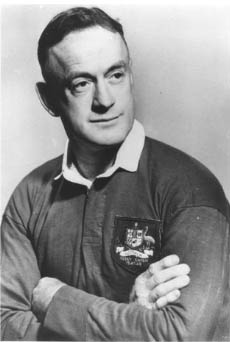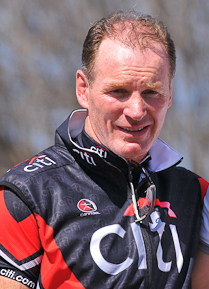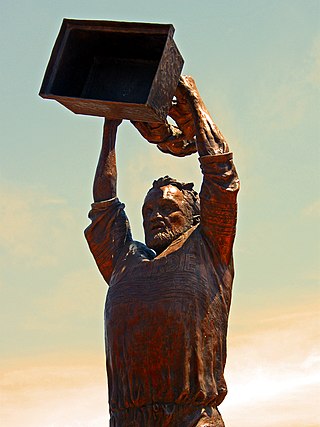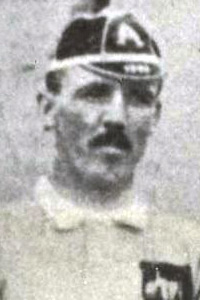Related Research Articles

Cyril Towers was an Australian rugby union player, a state and national representative centre who made 57 appearances for the Wallabies, played in 19 Test matches and captained the national team on three occasions in 1937.

Simon Paul Poidevin is a former Australian rugby union player who played as a flanker. Poidevin made his Test debut for Australia against Fiji during the 1980 tour of Fiji. He was a member of the Wallabies side that defeated New Zealand 2–1 in the 1980 Bledisloe Cup series. He toured with the Eighth Wallabies for the 1984 Australia rugby union tour of Britain and Ireland that won rugby union's "grand slam", the first Australian side to defeat all four home nations, England, Ireland, Wales and Scotland, on a tour. He debuted as captain of the Wallabies in a two-Test series against Argentina in 1986, substituting for the absent Andrew Slack. He was a member of the Wallabies on the 1986 Australia rugby union tour of New Zealand that beat the All Blacks, one of six international teams and second Australian team to win a Test series in New Zealand. During the 1987 Rugby World Cup, he overtook Peter Johnson as Australia's most capped Test player against Japan, captaining the Wallabies for the third time in his 43rd cap. He captained the Wallabies on a fourth and final occasion on the 1987 Australia rugby union tour of Argentina before injury ended his tour prematurely. In 1988, he briefly retired from international rugby, reversing his decision 42 days later ahead of the 1988 Bledisloe Cup series. Following this series, Poidevin returned to the Australian side for the single 1989 Bledisloe Cup Test. He returned full-time to the Australian national squad for the 1991 season. Poidevin was a member of the Wallabies that won the 1991 Rugby World Cup, after which he retired from international rugby union.

Raymond Alan Price is an Australian former dual-code international rugby union and rugby league footballer. He was nicknamed “Mr Perpetual Motion” for his hard, intimidating style of play in league at lock forward. Price played rugby league for Sydney's Parramatta Eels club, with whom he won four NSWRL premierships, a Dally M Medal and a Rothmans Medal. He also played in State of Origin for New South Wales.
Charlie Fox was an Australian rugby union player, a state and national representative second-rower who made 36 appearances for the Wallabies, playing in 17 Test matches and captained the national side on seven occasions in 1925.
Between July 1947 and March 1948 the Australia national rugby union team – the Wallabies – conducted a world tour encompassing Ceylon, Britain, Ireland, France and the United States on which they played five Tests and thirty-six minor tour matches. It was the first such tour in twenty years, since that of the 1927–28 Waratahs, as the 1939–40 Australia rugby union tour of Britain and Ireland tour had been thwarted by World War II. They were known as the Third Wallabies.
The 1984 Australia rugby union tour of Britain and Ireland was a series of eighteen matches played by the Australia national rugby union team in Britain and Ireland between 17 October and 15 December 1984. The Australian team won thirteen matches, drew one and lost four but notably won all four of their international matches.
Colin "Col" Windon, was a rugby union player and soldier who captained Australia – the Wallabies – in two Test matches in 1951. By age 18 Windon was playing at flanker for his club Randwick in Sydney's Shute Shield. After serving with the Second Australian Imperial Force in the Pacific Theatre during the Second World War, Windon resumed his rugby career in 1946. He was first selected for Australia for their tour of New Zealand that year. Despite the Wallabies losing both their Tests on tour, Windon impressed with his play.

Herbert John Solomon was an Australian rugby union player, a state and national representative versatile back who captained the Wallabies in eight Tests in the 1950s and led the touring squads to New Zealand and South Africa.

Anthony Alexander Shaw is an Australian former rugby union player. A Queensland state and national representative flanker, Shaw captained the national side consistently from 1978 to 1982.
Between October 1966 and March 1967 the Australia national rugby union team – the Wallabies – conducted a world tour on which they played five Tests and thirty-one minor tour matches. Under the captaincy of John Thornett they toured UK, Ireland, France and Canada winning nineteen matches, losing fourteen and drawing three. At one stage they failed to win in four successive matches although in the Test match against England they gave the home side its heaviest defeat in 16 years. The tour marked the climax of the successful "Thornett Era" of Australian Rugby, buoyed by the leadership skills of skipper John Thornett and the outstanding abilities of greats of the game like Ken Catchpole, Peter Johnson and Rob Heming. Dick Marks and Peter Crittle also toured and would later become among the most influential administrators of Australian rugby.

John James Carson was a rugby union player who represented Australia.
Desmond Michael Connor is an Australian former rugby union halfback who represented internationally both the Australian and New Zealand national rugby union teams. He is an inductee in the Australian Rugby Union Hall of Fame.
The 1912 Australia rugby union tour of Canada and the United States was a collection of friendly rugby union games undertaken by the Australia national rugby union team against various invitational teams from Canada and the U.S, and also against the US national team.
Robert Alfred Lewars Davidson (1926–1992) was an Australian rugby union footballer of the 1940s and 50s. A State and national representative prop-forward he made thirteen Test appearances and forty-nine additional tour match appearances for the Wallabies, captaining the national side in six Tests matches from 1957-58.
Robert Briton Loudon was a New Zealand born rugby union player, a flanker who made twenty-three representative appearances for the New South Wales state team in the 1920s. Seven of these matches have since been decreed as Test matches by the Australian Rugby Union and Loudon, who led the side in one such match in 1928, was therefore a captain of the Australian national team. After rugby union restarted in Queensland in 1929, and national selections were made from the two states Loudon played in six further full Australian Wallaby Test sides. In addition to his thirteen Test matches he made a further twenty-one tour match appearances for representative Australian sides on three international tours between 1923 and 1933.
Ron Walden was an Australian state and national representative rugby union player who captained the Wallabies in three Test matches in 1936.
Gregory Victor Davis was a New Zealand born, national representative rugby union player for Australia. He played at flanker and made seven international tours with Wallaby squads. He was the Australian national captain in 47 matches from 1969 to 1972 and led the Wallaby side on three overseas tours.

Peter George Johnson was an Australian international rugby union player. He enjoyed a long state and international career throughout the 1960s and made 92 national appearances for his country. He captained the Australian side in five Test matches.
Geoffrey Arnold Shaw is an Australian former national representative rugby union player who played for and captained the Wallabies. He made state representative appearances for both New South Wales and Queensland over an eleven-year period from 1969.
Robin John Heming was an Australian Lock/ No.8 rugby union player who played 21 tests for Australia between 1961 and 1967. Born in Namatanai in New Ireland off the then Australian Territory of New Guinea. He was educated at North Sydney Boys High School and qualified as an optometrist at what is now The University of New South Wales. He practised for many years on The Corso at Manly.